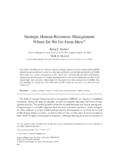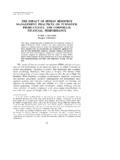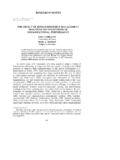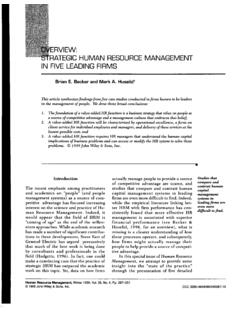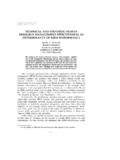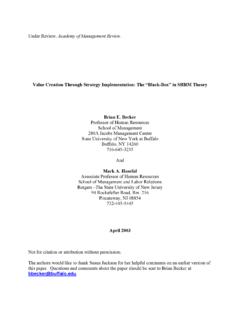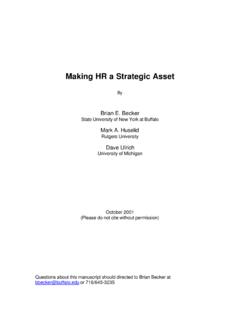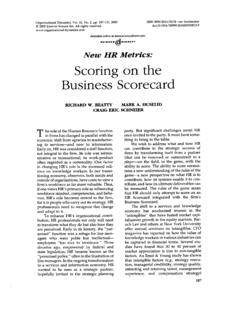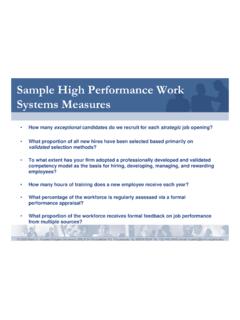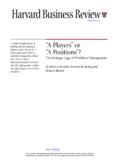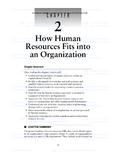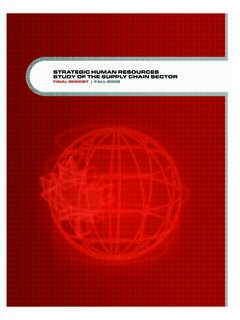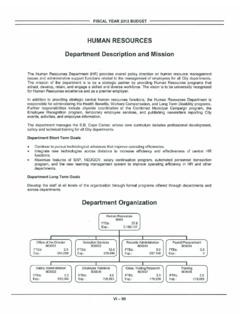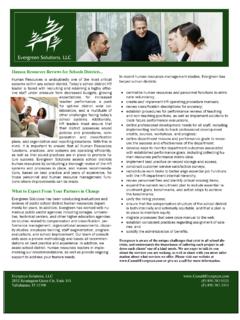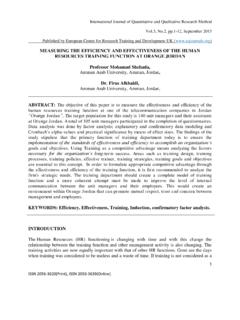Transcription of Submitted to the 1997 Academy of Management …
1 Submitted to the 1997 Academy of Management annual Meetings, human resource ManagementDivision. THE IMPACT OF HIGH PERFORMANCE WORK SYSTEMS, IMPLEMENTATION effectiveness , AND ALIGNMENT WITH STRATEGY ON SHAREHOLDER WEALTHbyMark A. HuselidSchool of Management and Labor RelationsDepartment of human resource ManagementRutgers Box 5062 New Brunswick, NJ 08903-5062(908) 445-5445email: Brian E. BeckerSchool of Management268 Jacobs Management CenterState University of New York at BuffaloBuffalo, NY 14260(716) 645-3235email: 3, 1997-------------------This study was partially funded by the School of Management and Labor Relations (SMLR)at Rutgers University and the SUNY-Buffalo School of Management . The interpretations,conclusions, and recommendations, however, are ours and do not necessarily represent thepositions of these organizations. 1(50)The Impact of High Performance Work Systems, Implementation effectiveness , and Alignment With Strategy on Shareholder WealthAbstract (max 50 words)We estimate the impact of the presence of a High Performance Work System and its effectiveness and alignment with firm competitive strategy on shareholder wealth in 702 firms.
2 Wefind that a one standard deviation increase in these factors is associated with a $42,000 peremployee increase in market value. 2 The Impact of High Performance Work Systems, Implementation effectiveness , and Alignment With Strategy on Shareholder WealthThe nature and pace of recent changes in the economic environment have motivated bothmanagers and scholars to look for new sources of competitive advantage and profitability. As manyof the traditional sources of competitive advantage (technology, economies of scale, patents, etc.)have diminished in value, the role of a skilled, motivated and flexible workforce has become moreprominent (Pfeffer, 1994). The form and structure of organizational policies and practices that mightproduce such a work force, and in turn have an economically meaningful effect on firm performance,has been the focus of an emerging literature in strategic human resource Management (HRM).
3 Within that context a broadly defined High Performance Work System (HPWS) can be viewed as akey strategic lever, both as a means to develop and sustain core competencies and as a necessarycondition for strategy implementation (Dyer, 1993; Pfeffer, 1994; Levine, 1995). Such systemsinclude rigorous recruiting and selection protocols, performance Management and incentivecompensation systems, and employee training and development activities that are designed toacquire, refine, and reinforce employee skills and behaviors necessary to implement the firm scompetitive strategy (Huselid, 1995). Indeed, HPWS have attracted considerable interdisciplinaryinterest and been the subject of recent special issues in three leading journals ( Academy ofManagement Journal, Industrial Relations, Journal of Accounting and Economics). This study focuses on a recurring theme in this literature; namely, to what extent is the HRM-firm performance relationship contingent upon the degree to which such systems have beenimplemented effectively, the fit among HRM policies, and the fit between those polices and thefirm s larger strategic objectives?
4 Prior empirical work on this topic reflects an inherent tensionbetween methodology and theory. The underlying theoretical literature suggesting the presence of aHRM-firm performance relationship focuses on comprehensive firm-level measures of financialperformance (Hamel and Prahalad, 1994). However, the extent of implementation effectiveness , the fit among HR policies, and their consistency with larger business objectives, are more easilyobserved within individual plants and industry sectors; the focus of most of the empirical work on thisissue (Arthur, 1992; Cutcher-Gershenfeld, 1992; MacDuffie, 1995; Youndt, Snell, Dean, & Lepak,1996). Perhaps not surprisingly, while mixed, the empirical support for the benefits of contingenciestends to be stronger as the level of analysis approaches the plant or unit level (Becker and Gerhart,1996). We believe it is equally important to establish similar relationships at the level of the firm.
5 1 Such efforts will not only provide a complement to more narrowly focused analyses, and therebypromote theory development in this literature, but also address the most salient concerns of this paper we extend the empirical literature on this topic by examining firm performanceeffects of the HR system as well as the broader organizational context that supports and reinforces ahigh performance HR Management system. We term this latter dimension of the firm s HR strategyEffectiveness and Alignment because it includes conventional notions of fit and contingency, butdefines these contextual factors more broadly to include both senior leadership style and HR functioneffectiveness. We compare this broader measure of fit with more conventional estimates based oninteractions, including those with generic measures of corporate strategy (Porter, 1985). Our resultsindicate strong support for a positive relationship between a high performance HR system and firmperformance.
6 The evidence supporting the effectiveness and Alignment strategy is mixed. Thestrongest support for complementarities is suggested by a pattern of strategy configurations (Delery& Doty, 1996) derived from cluster analysis. THEORETICAL BACKGROUND AND HYPOTHESESThe prior conceptual literature speaks both to the mechanism through which the HRmanagement system might affect firm performance as well as the necessary conditions for these3systems to have a strategic impact. The behavioral perspective (Jackson, Schuler, & Rivero, 1987)suggests that an effective HR Management system will acquire, develop and motivate the behaviorsnecessary to enhance firm performance (Bailey, 1993; Jackson et al., 1987; Pfeffer, 1994; Schuler &MacMillan, 1984). Complementary work argues that HR Management systems provide additionalvalue when they are purposively designed to be internally consistent and are thereafter linked withfirm competitive strategy (Butler, Ferris, & Napier, 1991; Cappelli & Singh, 1992; Jackson & Schuler,1995; Milgrom & Roberts, 1995; Ulrich & Lake, 1990; Wright & MacMahan, 1992).
7 In essence, priortheoretical work in this area concludes that competitive advantage is in part a product of HRmanagement systems that elicit employee behaviors consistent with the firm's broader strategic andenvironmental contingencies (Jackson & Schuler, 1995).Promoting desirable employee behaviors, however, is not sufficient to create a strategicimpact. Following the resource -based view of the firm (Barney, 1991) it is clear that if these HRmanagement systems are to in fact create sustained competitive advantage, they must be difficult toimitate. HPWS are characterized by at least two features that are associated with inimitability: pathdependency and causal ambiguity (Collis and Montgomery, 1995). Path dependency describesorganizational policies that are developed over time and cannot be simply purchased in the marketby competitors. A competitor can understand that a particular policy or practice is valuable andwould like to adopt it, but is precluded from immediate imitation by the time required to fullyimplement the strategy.
8 Causal ambiguity reflects policies that are easily understood in concept, butin practice require numerous and subtle interrelationships that are not readily observed by thoseoutside the firm. An example is the challenge of aligning HR policies with the firm s strategy andtheir larger embeddedness in Management practice (Lengnick-Hall & Lengnick-Hall, 1988; Lado &Wilson, 1994). The behavorial perspective describes how the HR Management system creates new firmcapabilities, while resource -based view emphasizes the attributes required for these capabilities togenerate competitive advantage. Complementarities within the HRM system, as well as thealignment of the HR strategy with appropriate business strategies and goals, therefore provide atheoretical rationale for a positive link between HR and firm financial performance. This notion isalso consistent with recent theoretical work in the field of strategic Management (Amit andShoemaker, 1993) that develops the concept of strategic assets as "the set of difficult to trade andimitate, scarce, appropriable, and specialized resources and capabilities that bestow the firm'scompetitive advantage" (pg.)
9 36). Our view is that HR strategies that successfully develop andimplement a coordinated HPWS create "invisible assets" (Itami, 1987) that both create value and aredifficult to imitate. These asset values are maximized when the HPWS is so embedded in theoperational systems of the organization that it enhances a firm's capabilities. Therefore, unlike moretraditional "personnel" activities, organizational high performance work systems have a strategicimpact at the level of the firm. This interpretation is also consistent with the recent emphasis on"core competencies" developed by Hamel and Prahalad (1994) who argue that conventionalmeasures of economic rents such as the difference between market and book value of assets ( ,Tobin's q) reflect "core competence, (or) people embodied skills" (pg. 232). Following this logic, weexpect that: Hypothesis #1: The presence of a High Performance Work System will be positivelyassociated with corporate financial performance.
10 Complementarities and HR BundlesThe theoretical rationale that HR can represent a strategic asset requires that the HRstrategy of a successful firm not be easily imitated by its competitors. The logic of inimitability has inpart motivated the focus on complementarities (Milgrom and Roberts, 1995), bundles (MacDuffie,1995; Arthur, 1994; Ichniowski, Shaw, & Prennushi, 1994) and systems (Delery & Doty, 1996;Huselid, 1995; Jackson & Schuler, 1995) rather than the emphasis on individual HR policies andpractices that characterizes much of the traditional HR literature. Milgrom and Roberts (1995)4develop a theoretical rationale for both the internal (within the HR Management system) and external(with firm competitive strategy) alignment of an HR Management system. In their viewcomplementarities or synergies related to HR Management practices are possible when an internallyconsistent and externally aligned system of such practices is adopted.
